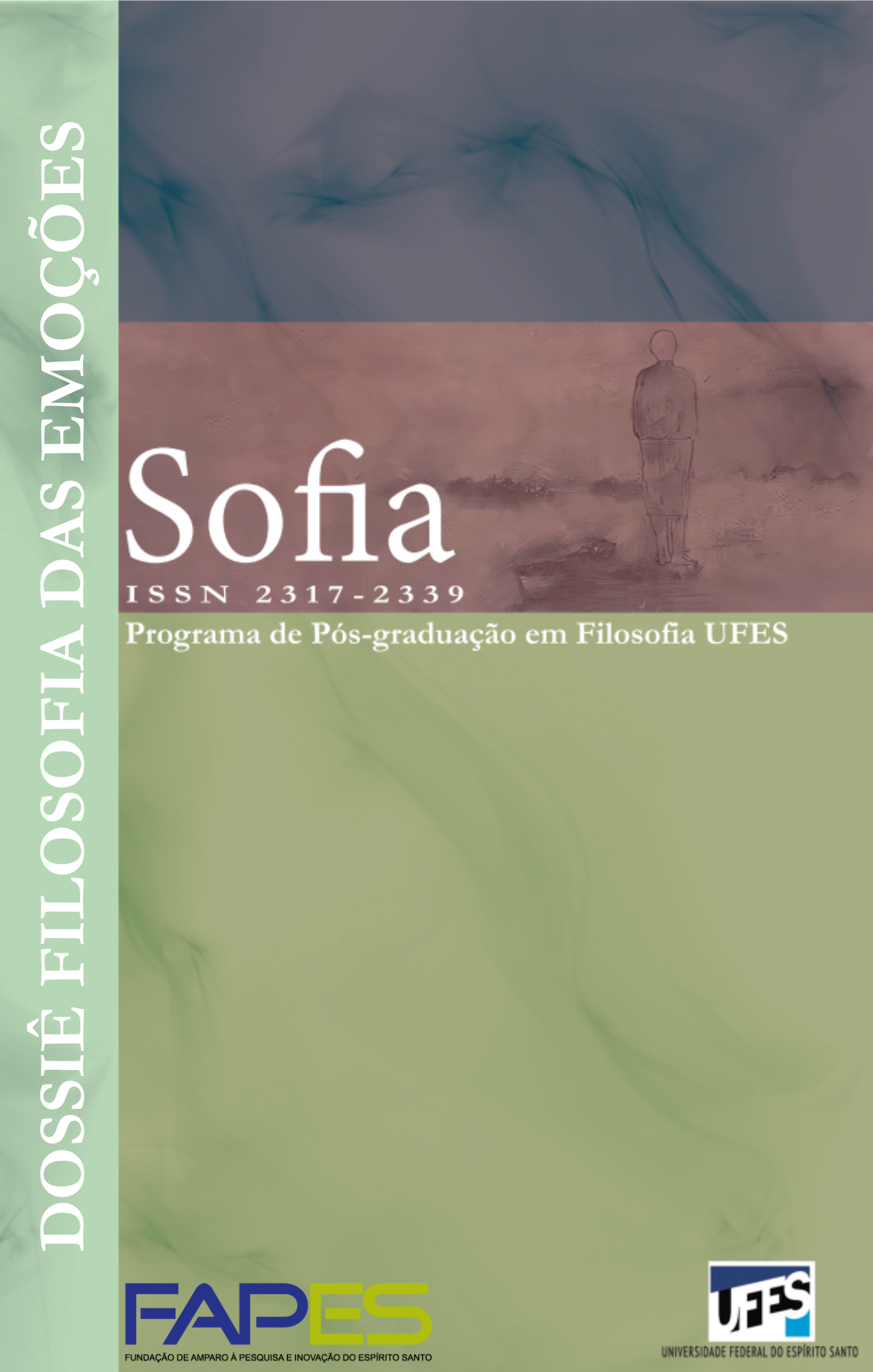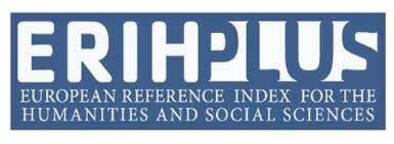Uma revisão de escopo dos estudos sobre as expressões faciais de emoção e a língua de sinais
DOI:
https://doi.org/10.47456/sofia.v12i2.42002Palavras-chave:
comunicação não verbal, expressão facial de emoção, língua de sinaisResumo
As expressões faciais de emoção são universais e compreendidas por todos os seres humanos. Entretanto, para os usuários de língua de sinais, as expressões faciais também são usadas como marcadores linguísticos. Objetivou-se realizar uma revisão de escopo da produção científica sobre a relação entre o uso de língua de sinais e a percepção e reconhecimento de expressões faciais de emoção. Os dados foram coletados na APA PsycNEt, Scientific Eletronic Library Online –Scielo e Scopus. Foram identificadas 376 publicações e selecionados 15 artigos segundo os critérios de inclusão e exclusão e da PRISMA-ScR. A maioria das publicações foram realizadas com participantes surdos sinalizadores em comparação com ouvintes não sinalizadores; os principais estímulos utilizados nos estudos foram imagens estáticas (fotografias de expressões faciais de emoção); a maioria dos estudos não encontrou diferenças significativas entre os participantes surdos com conhecimento em língua de sinais e ouvintes sem conhecimento em língua desinais.
Referências
ALVES, N. T. Recognition of static and dynamic facial expressions: a study review. Estudos de Psicologia (Natal), v. 18, n. 1, p. 125–130, mar. 2013.
AZEVEDO, C. B. DE; GIROTO, C. R. M.; SANTANA, A. P. DE O. Produção científica na área da surdez: Análise dos artigos publicados na Revista Brasileira de Educação Especial no período de 1992 a 2013. Revista Brasileira de Educação Especial, v. 21, p. 459-476, 2015.
BETTGER, J. G. et al. Enhanced facial discrimination: effects of experience with American sign language. Journal of deaf studies and deaf education, v. 2, n. 4, p. 223–233, 1 jan. 1997.
BOULD, E.; MORRIS, N. Role of motion signals in recognizing subtle facial expressions of emotion. British Journal of Psychology, v. 99, n. 2, p. 167–189, maio 2008.
BRASIL. Lei no 10.436, de 24 de abril de 2002. Dispõe sobre a Língua Brasileira de Sinais-Libras e dá outras providências. [s.l.] Diário Oficial da União, 2002.
BRASIL. Decreto no 5.626, de 22 de dezembro de 2005. Regulamenta a Lei no 10.436, de 24 de abril de 2002, que dispõe sobre a Língua Brasileira de Sinais-Libras. [s.l.] Diário Oficial da União, 2005.
CLAUDINO, R. G. E et al. Use of sign language does not favor recognition of static and dynamic emotional faces in deaf people. Psychology & Neuroscience, v. 13, n. 4, p. 531–538, dez. 2020.
CORINA, D. P.; BELLUGI, U.; REILLY, J. Neuropsychological studies of linguistic and affective facial expressions in deaf signers. Language and Speech, v. 42, n. 2–3, p. 307–331, 1999.
DE VOS, C.; VAN DER KOOIJ, E.; CRASBORN, O. Mixed Signals: Combining Linguistic and Affective Functions of Eyebrows in Questions in Sign Language of the Netherlands. Language and Speech, v. 52, n. 2–3, p. 315–339, 3 jun. 2009.
DOBEL, C. et al. Deaf signers outperform hearing non-signers in recognizing happy facial expressions. Psychological Research, v. 84, n. 6, p. 1485–1494, 1 set. 2020.
EKMAN, P. Facial expression. Handbook of cognition and emotion, v. 16, p. 301–320, 1999.
EKMAN, P.; FRIESEN, W. V. Facial action coding system. [s.l.] Environmental Psychology y Nonverbal Behavior, 1978.
ELFENBEIN, H. A.; AMBADY, N. Universals and Cultural Differences in Recognizing Emotions. Current Directions in Psychological Science, v. 12, n. 5, p. 159–164, 24 out. 2003.
FIGUEIREDO, L. M. B.; LOURENÇO, G. O movimento de sobrancelhas como marcador de domínios sintáticos na Língua Brasileira de Sinais. Revista da Anpoll, v. 1, n. 48, p. 78–102, 25 jun. 2019.
GÓES, A. M.; CAMPOS, M. DE L. I. L. Aspecto da Gramática da Libras. Em: LACERDA, C. B. F.; SANTOS, L. F. (Eds.). Tenho um aluno surdo e agora? Introdução a Libras e educação dos surdos. EdUFSCar ed. [s.l.]: 2008. p. 65–80.
GOLDSTEIN, N. E.; FELDMAN, R. S. Knowledge of American Sign Language and the ability of hearing individuals to decode facial expressions of emotion. Journal of Nonverbal Behavior, v. 20, n. 2, p. 111–122, 1996.
GOLDSTEIN, N. E.; SEXTON, J.; FELDMAN, R. S. Encoding of facial expressions of emotion and knowledge of American sign language. Journal of Applied Social Psychology, v. 30, n. 1, p. 67–76, 2000.
GROSSMAN, R. B.; KEGL, J. To capture a face: A novel technique for the analysis and quantification of facial expressions in American Sign Language. Sign Language Studies, v. 6, n. 3, mar. 2006.
GROSSMAN, R. B.; KEGL, J. Moving faces: Categorization of dynamic facial expressions in American sign language by deaf and hearing participants. Journal of Nonverbal Behavior, v. 31, n. 1, p. 23–38, mar. 2007.
JONES, A. C.; GUTIERREZ, R.; LUDLOW, A. K. The role of motion and intensity in deaf children’s recognition of real human facial expressions of emotion. Cognition & emotion, v. 32, n. 1, p. 102–115, 2 jan. 2018.
JONES, A. C.; GUTIERREZ, R.; LUDLOW, A. K. Emotion production of facial expressions: A comparison of deaf and hearing children. Journal of Communication Disorders, v. 92, 1 jul. 2021.
KEATING, C. F. The developmental arc of nonverbal communication: Capacity and consequence for human social bonds. Em: APA handbook of nonverbal communication. Washington: American Psychological Association, 2016. p. 103–138.
KREJTZ, I. et al. Attention Dynamics During Emotion Recognition by Deaf and Hearing Individuals. The Journal of Deaf Studies and Deaf Education, 29 out. 2019.
LEWIS, M.; SULLIVAN, M. W.; VASEN, A. Making faces: Age and emotion differences in the posing of emotional expressions. Developmental Psychology, v. 23, n. 5, p. 690–697, set. 1987.
LIDDELL, S. K. Grammar, Gesture, and Meaning in American Sign Language. [s.l.] Cambridge University Press, 2003.
LINS, H. A. DE M.; NASCIMENTO, L. C. R. Algumas tendências e perspectivas em artigos publicados de 2009 a 2014 sobre surdez e educação de surdos. Pro-Posições, v. 26, n. 3, p. 27–40, dez. 2015.
LUDLOW, A. et al. Emotion recognition in children with profound and severe deafness: Do they have a deficit in perceptual processing? Journal of Clinical and Experimental Neuropsychology, http://dx.doi.org/10.1080/13803391003596447 , v. 32, n. 9, p. 923–928, nov. 2010.
MATSUMOTO, D.; HWANG, H. C. The cultural bases of nonverbal communication. Em: APA handbook of nonverbal communication. Washington: American Psychological Association, 2016. p. 77–101.
MCCULLOUGH, S.; EMMOREY, K. Face Processing by Deaf ASL Signers: Evidence for Expertise in Distinguishing Local Features. Journal of Deaf Studies and Deaf Education, v. 2, n. 4, p. 212–222, 1 jan. 1997.
MIGUEL, F. K. Psicologia das emoções: uma proposta integrativa para compreender a expressão emocional. Psico-USF, v. 20, n. 1, p. 153–162, abr. 2015.
PEREIRA, I.; SENHEM, P. R. ATUALIZAÇÕES SOBRE INTERNACIONALIZAÇÃO DA EDUCAÇÃO DE SURDOS. Revista e-Curriculum, v. 19, n. 2, p. 729–747, 30 jun. 2021.
PFAU, R.; JOSEP, Q. Nonmanuals: their grammaticaland prosodicroles. Cambridge University, p. 381–402, 2010.
QUADROS, R. M. Língua de sinais brasileira: estudos linguísticos. Artmed. ed. [s.l.] 2004.
QUADROS, R. M.; SCHMIEDT, M. L. Ideias para ensinar português para alunos surdos. Brasılia: Mec, SEESP ed. [s.l.] 2004.
SANTOS, H. R. TRAÇOS NÃO MANUAIS DE EVENTUALIDADES EM LIBRAS. Estudos Linguísticos e Literários, n. 72, p. 126–148, 10 maio 2022.
SHALEV, T. et al. Do deaf individuals have better visual skills in the periphery? Evidence from processing facial attributes. Visual Cognition, v. 28, n. 3, p. 205–217, 15 mar. 2020.
SIDERA, F.; AMADÓ, A.; MARTÍNEZ, L. Influences on Facial Emotion Recognition in Deaf Children. Journal of deaf studies and deaf education, v. 22, n. 2, p. 164–177, 1 abr. 2017.
STOLL, C. et al. Quantifying Facial Expression Intensity and Signal Use in Deaf Signers. The Journal of Deaf Studies and Deaf Education, v. 24, n. 4, p. 346–355, 1 out. 2019.
TRICCO, A. C. et al. PRISMA Extension for Scoping Reviews (PRISMA-ScR): Checklist and Explanation. Annals of Internal Medicine, v. 169, n. 7, p. 467–473, 2 out. 2018.
WEISEL, A. Deafness and perception of nonverbal expression of emotion. Perceptual and motor skills, v. 61, n. 2, p. 515–522, 1985.
XAVIER, A. N. Análise preliminar de expressões não-manuais lexicais na libras. Revista Intercâmbio, v. XL, p. 41–66, 2019.
Downloads
Publicado
Edição
Seção
Licença
Copyright (c) 2023 Rafael Guilherme, Rosana Suemi Tokumaru

Este trabalho está licenciado sob uma licença Creative Commons Attribution 4.0 International License.
Dada a política de acesso público da revista, o uso dos textos publicados é gratuito, com a obrigação de reconhecer a autoria original e a primeira publicação nesta revista. Os autores das contribuições publicadas são inteiramente e exclusivamente responsáveis por seus conteúdos.
I Os autores autorizam a publicação do artigo nesta revista.
II Os autores garantem que a contribuição é original e assumem total responsabilidade pelo seu conteúdo em caso de impugnação por terceiros.
III Os autores garantem que a contribuição não está sob avaliação em outra revista.
IV Os autores mantêm os direitos autorais e concedem à revista o direito de primeira publicação, sendo o trabalho licenciado sob uma Licença Creative Commons Atribuição-BY.
V Os autores são autorizados e incentivados a divulgar e distribuir seu trabalho on-line após a publicação na revista.
VI Os autores dos trabalhos aprovados autorizam a revista a distribuir seu conteúdo, após a publicação, para reprodução em índices de conteúdo, bibliotecas virtuais e similares.
VII Os editores reservam o direito de fazer ajustes no texto e adequar o artigo às normas editoriais da revista.


















